Managing Process Flows
|
Topics: |
Creating a Process Flow
|
Topics: |
|
How to: |
You must create a project before you can design a process flow. If you have not created a project, see Creating a Project for instructions.
Creating a process flow in iIT Designer is a drag-and-drop operation. Every process flow begins with a Start object, which appears in the workspace by default when you create a new process flow. A process flow must also contain at least one end object, which you can add to the workspace at any time. You cannot validate or publish a process flow without an end object.
To create a process flow, you will include one or more of the objects provided by iIT Designer. After you add an object to the process flow, you then establish a relationship between that object, and the previous object in the flow. This relationship defines how, and under what conditions, you can route the document through the process flow.
Procedure: How to Create a Process Flow
There are two methods to create a new Process Flow:
- On the main
menu bar, click File, then New.
Select Other... from the drop-down list,
as shown in the following image.
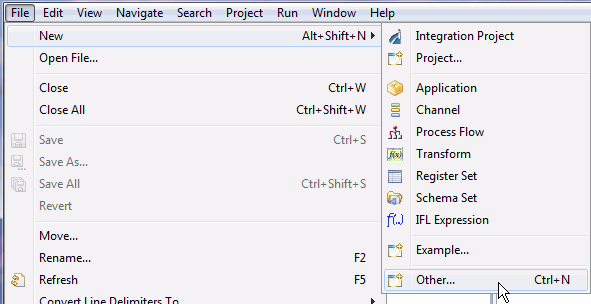
- In the Select
a wizard pane, expand the iWay Integration folder, select Process
Flow, and click Next.
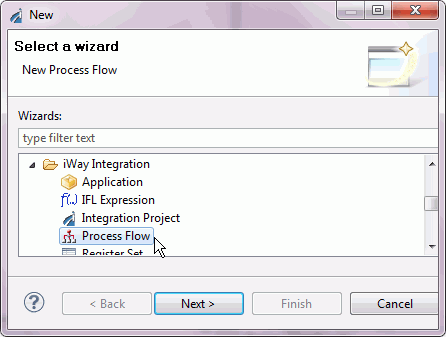
- You may
also create a new Process Flow by right-clicking on the Flows folder
of the desired project. Click New and Process
Flow, as shown in the following image.
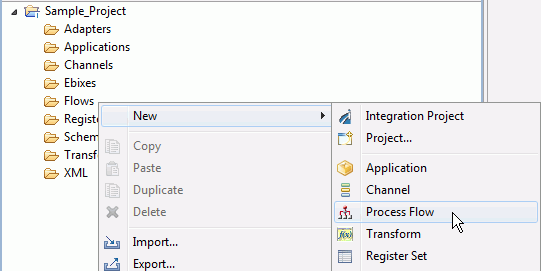
- The General
Properties dialog box is displayed, as shown in the following image.
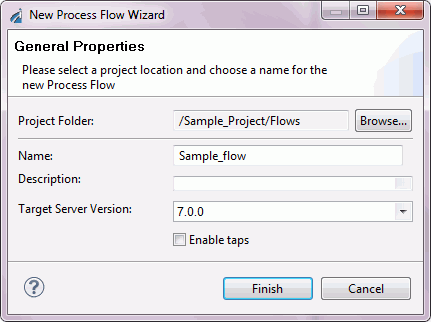
- In the Project Folder field, use the Browse button to select a folder to contain the new Process Flow.
- In the Name field, type a descriptive name for the process flow.
- In the Description field, optionally enter a description for the new Process Flow.
- Using the Target Server Version drop-down list, optionally select a non-default target version, .
- Select the Enable taps check box to enable real-time data capture and reporting. For more information on configuring and using Taps, see the iWay Enable User's Guide .
- Click Finish.
The new Process Flow is listed in the Integration Explorer view
in the selected location. The workspace displays a Start object,
and the Properties pane appears below, displaying the properties
of the Start object.
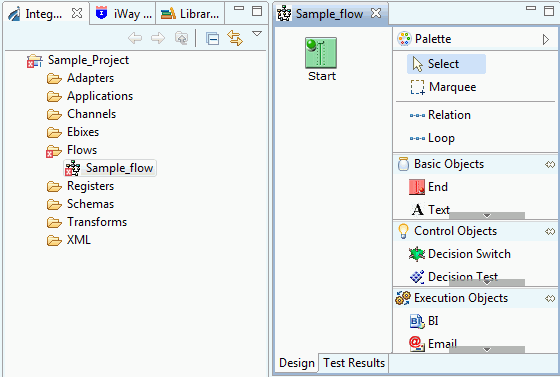
You are ready to add objects to the process flow.
Adding Objects to a Process Flow
Once you have created a process flow, you can continue to modify its design by adding objects according to your requirements. Every process flow requires at least one End object to terminate the flow. This section describes how to include an object in your process flow. For details about each object available to you in iIT Designer, see Defining Process Flow Objects .
Procedure: How to Add an Object to the Process Flow
To add an object to the process flow:
- From the
Object toolbar, click the object icon you want to add, and either
drag it to the workspace, or click a blank area of the workspace.
Note: You can also right-click a blank area of the workspace. Select the object you wish to add from the New Process Flow Object dialog box.
The New (type) Object dialog box for the selected object opens. The following image shows an example of this dialog box for a new File object.
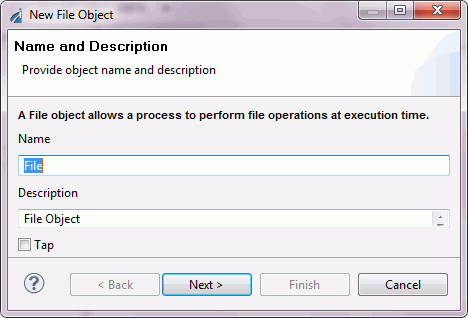
See Defining Process Flow Objects for details on defining the objects that are available in Designer.
- In the Name field, type a name for the object, or accept the default.
- In the Description field,
type a brief description of the object, or accept the default.
Depending on the object you are adding, this dialog box also includes the following option.
- Tap. Select the Tap check box to enable real-time data capture and reporting. The Tap option is selected by default if you enabled Taps while creating a new process flow. For more information on configuring and using Taps, see the iWay Enable User's Guide.
- Click Next.
Depending on the object you choose, there are one or more dialog boxes that present the parameter options for the object.
- When you are finished defining the object, click Finish.
The new object appears in the workspace. You can drag it to any position in the workspace.
Building Relationships Between Objects
The relationship between two or more objects in a process flow is represented by a color-coded line with an arrow that directs the flow of the XML input document. You define the relationships between objects as you build your process flow. If necessary, you can change the line properties, just as you can the object properties, of an existing process flow.
This section explains how to create a relationship between objects and how to edit existing relationships.
Procedure: How to Build a Relationship Between Objects
To build a relationship between objects:
- Select the object from where the document originates, and then hold the Shift key to select the object that will receive the document.
- Right-click
the object that will receive the document, and select Create
Relation from the menu options.
The Relation Configuration dialog box opens. The following image is an example of this dialog box with an OnCompletion Event.
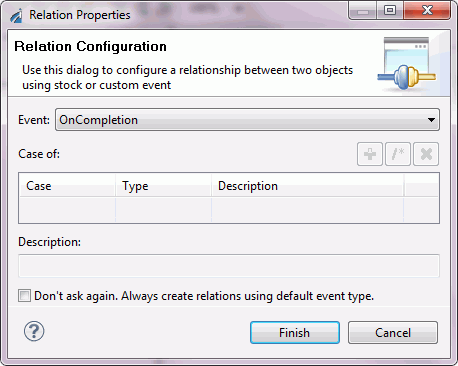
- Select the
event for the selected objects from the Event drop-down
list.
The default (stock) events that appear depend on the objects you are working with. For instance, the first relationship you build between a Start object and another object allows only the OnCompletion event for that relationship. The lines in the workspace that represent the relationship between two objects are color coded for quick identification. The following list describes the available events and the corresponding color.
- OnCompletion. Represented by a blue line. Indicates there are no conditions; always follow the path.
- OnError. Represented by a red line. Follow the path if there is a JAVA exception.
- OnSuccess. Represented by a green line. Follow the path if there is normal completion.
- OnCustom. Represented by a brown line. Allows you to customize the path condition.
- OnFailure. Represented by a maroon line. Follow the path if a coded error occurs, for example, an agent that is coded to issue an error when it is unable to connect to a server.
If you select OnCustom, a list of Case of options appears, allowing you to customize the event for a particular condition, such as true or false. The following image shows this dialog box for the line configuration between a Decision Switch object and an End object, and contains an Event drop-down list, and a table with three columns: Case, Type, and Description.
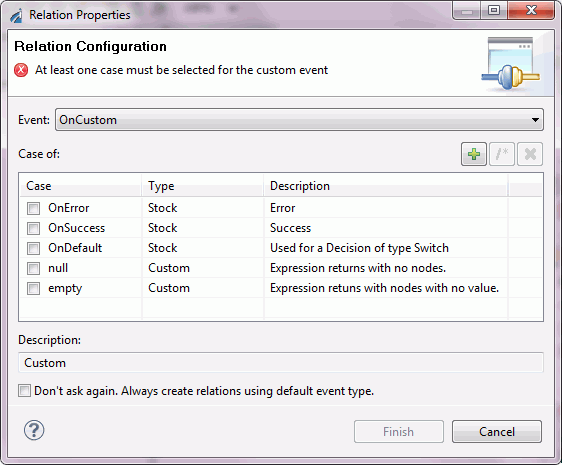
- Click Finish.
A line appears between the two objects to indicate a relationship is established.
Procedure: How to Edit the Relationship Between Objects
If you want to change the properties of an existing relationship:
- Click the line that represents the relationship you want to edit.
- The relation
properties are displayed in the Properties tab, in the bottom portion
of the console.
The Properties pane provides an Event drop-down list, along with Case of and Description fields.

- Change the property as needed. (The properties of the relationship object change simultaneously.)
The new line properties are now in place.
Saving a Process Flow
To save a process flow, highlight the process flow node, and select Save from the File menu.
Validating a Process Flow
Validating a process flow determines that the process flow structure is correct. For example, validating a process flow determines that all objects are connected.
To validate a process flow, right-click the Flows node and select Validate from the list. A pop-up window appears, as shown in the following image.

Compiling a Process Flow
Compiling a process flow sends the flow to iWay Service Manager to verify that it works in a run-time environment. Compiling as part of creating a process flow is optional, since it is automatically done as part of the test option. The compile option is useful if you are debugging a process flow. It allows you to check the flow using a step-by-step approach.
To compile a process flow, right-click the process flow you want to compile. Select Integration Tools from the list, and then select Compile, as shown in the image below.
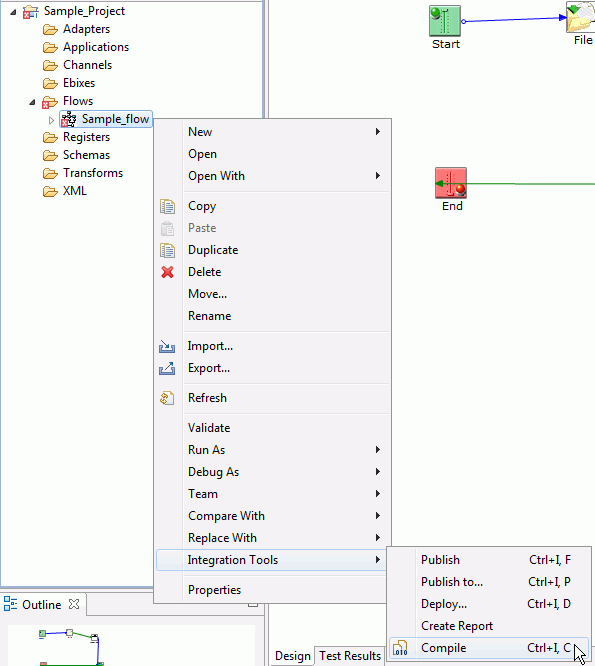
Testing a Process Flow
|
How to: |
iIT Designer provides a test feature to test the function of a process flow using an input XML document.
The following procedure explains how to use the Test feature.
Procedure: How to Test a Process Flow
- Click the Run button,
or right-click the process flow you want to test and select Run
as, then Process Flow from the
drop-down list.
The Edit configuration and launch dialog box opens, as shown in the following image.

- In the Main tab, browse to select the process flow in the Process Flow field.
- An input document is required for a Test Run. Click the ellipsis button (...) to browse, or click the Import button to import an Input Document.
- In the Server Environment area, in the URL field, type the address of the Service Manager where you want to test the process flow in the URL field.
- To access Service Manager, type the User Name and Password in the corresponding fields.
- Choose between
the following options:
- Use minimal runtime configuration with dependencies deployed from the registry.
- Use test server.
- Use existing configuration. Click the Get Configurations button to access existing configurations.
- Click the Test
Server tab. The dialog box is displayed, as shown in
the following image.
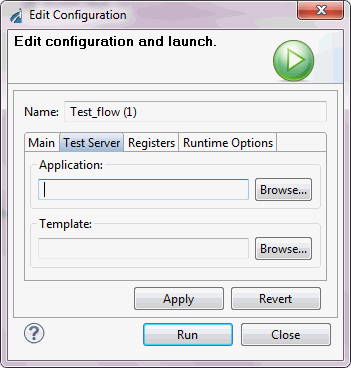
- Browse to select the Application and Template if required.
- Click the Registers tab.
The dialog box is displayed, as shown in the image below.
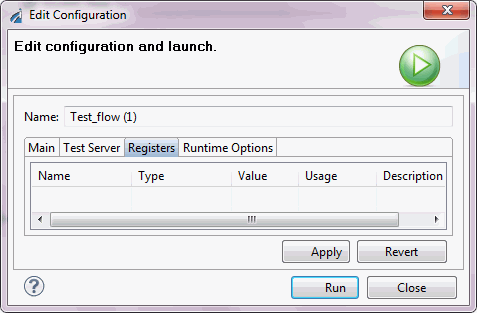
- You can enter SREG values to be used in the process flow, which will override the values set through either the iWay Service Manager console, server configuration, or Register Sets.
- Click the Runtime
Options tab. The dialog box is displayed, as shown in
the image below.
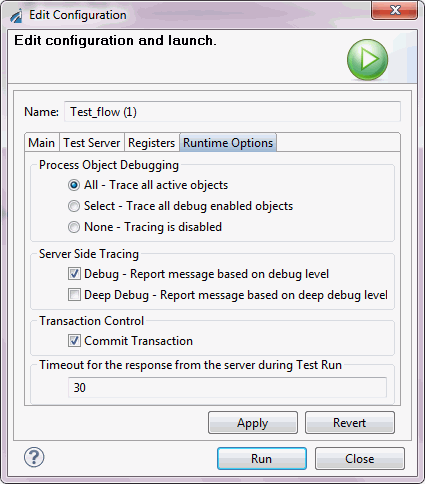
- Select the
Process Object Debugging option, as follows:
All. Traces all active objects.
Select. Traces all debug enabled objects.
None. Disables tracing.
- Select the
server side tracing, as required.
Debug. Reports progress traces of the test.
Deep Debug. Reports additional traces and details about errors.
- Choose whether
or not to set the Transaction Control option, Commit Transaction.
This determines whether or not the work scheduled in the process flow is actually performed during the test, for example, inputting records to a database.
- Input the timeout for the response from the server during Test Run. The default is 30 seconds.
- Click Apply.
Click Run.
The test results appear in the Console tab of the Properties pane.
Publishing a Process Flow
|
How to: |
Publishing a process flow makes the process flow available to either a system or to a channel that was created in Service Manager. A process flow published to a system can run as a global document or be used by an iWay adapter to create a web service.
You can only publish valid and compiled process flows. A single process flow can be published to multiple listeners and systems. See Validating a Process Flow for the validation procedure and Compiling a Process Flow for information on compiling a process flow.
There are three options to publish a process flow:
- Publish. Opens a series of publication setup dialog boxes through which you direct the publication.
- Default Publish. Uses the default Service Manager instance, but allows you to select new publishing locations (system and listener(s)).
- Republish. Publishes the process flow using the previous settings. This option is useful if you edit a process flow and want to republish it with the previous publication settings.
Designer provides a tool called Publication Management that allows you to view the process flows published to a particular Service Manager configuration. Through this tool, you can also unpublish any process flow currently published to a Service Manager configuration. This section provides the procedures to publish and unpublish a process flow.
Procedure: How to Publish a Process Flow
To publish a process flow:
- Right-click
the process flow you want to publish, and select Integration
Tools from the list. Then select, Publish .
The Publishing Resource Wizard dialog box opens. An example of this dialog box is shown in the following image.

- From the Server URL drop-down list, choose the Service Manager server to which you want to publish the flow.
- In the User Name field, type a valid user name for the Service Manager server.
- In the Password field, type a valid password for the Service Manager server.
- Click Finish.
- Click Next.
The Publish To dialog box opens, as shown in the following image.
- Select iWay Registry or Configuration ID as the destination to which to publish the process flow.
- Click Next.
The Select Publication Location(s) dialog box opens, as shown in the following image. This dialog box shows the publication locations (systems and listeners) for the selected Service Manager and configuration. The locations are listed in a table with three columns; Name, Type, and Description.
You can publish a flow to a system, a configured listener, and (if defined) a global document. You can also choose to overwrite any flows that are currently published.
- In the Name column, select a system and/or the listener(s) to which you want to publish the process flow. To select all items in the Name column, click Check All.
- Select, or deselect Overwrite existing published process(es) and, Refresh listener after publication, as needed.
- Click Finish.
The Message Log pane displays the publishing status.
An example of the status display when publishing to a system is shown in the following image.

Note: You can publish only one process flow to a listener.
Procedure: How to Use the Default Publish Option
This option uses the default publication server (Service Manager) and configuration, but allows you to select the publication locations.
- In the Project
tab of the Navigator pane, right-click the process flow you want
to publish, and select Default Publish from
the drop-down list.
The Select Publication Location(s) dialog box opens, as shown in the following image. This dialog box shows the publication locations (system and listener(s)) for the default Service Manager and configuration. The publication locations are listed in a table with three fields: Name, Type, and Description.
- In the Name column, select the system and/or listeners to which you want to publish the process flow. To select all items in the Name column, click Check All.
- Select, or deselect Overwrite existing published process(es) and, Refresh listener after publication, as needed.
- Click Finish.
The Message Log pane displays the publishing status.
Procedure: How to Republish a Process Flow
To republish a process flow:
- Right-click
the process flow you want to republish and select Republish from
the drop-down list.
The publication process uses the previous publication settings (publication server and locations) to publish the process flow. The publication results appear in the Message Log pane.
For an example of publication results, see How to Publish a Process Flow.
Procedure: How to Unpublish a Process Flow
You can only unpublish a process flow from a run-time configuration. To remove a process flow from a Registry, use the iWay Service Manager console, as described in the iWay Service Manager User’s Guide.
Use the following procedure to view the published process flows on a particular publication server and to unpublish a process flow that is currently published.
- Select Publication
Management from the Tools menu or click the Publication
Management icon located in the toolbar.
The Unpublishing Process(es) - Locate a Publication Server dialog box opens, as shown in the following image.
- From the Server URL drop-down list, choose the Service Manager server you want to access.
- In the Login pane, type a valid user name and password in the corresponding fields for the Service Manager server.
- Click Next.
The Select Server Configuration dialog box opens, as shown in the following image.
- From the Configuration ID drop-down list, choose the configuration you want to access.
- Click Next.
The Unpublish Operation dialog box opens. An example of this dialog box is shown in the following image. The processes are listed in a table with three fields: Name, Type, and Description.
- In the Name column, select the process flow(s) you want to unpublish. If you want to select all process flows on this configuration, click Check All.
- Click Finish.
The Publication Management tool closes and the results appear in the Message Log pane. The following image shows an example of the results for a process flow named SWIFT_ROUTER..

The process flow has been removed from the publication server.
Exporting a Process Flow
|
How to: |
A process flow can be exported as an XML file where it is accessible by another Service Manager or a version control system, such as Microsoft Visual SourceSafe.
Procedure: How to Export a Process Flow
To export a process flow:
- In the Navigator
pane, right-click the process flow that you want to export, and
select Export from the drop-down list.
The standard Windows Save As window opens.
- Choose the location where you want the XML file to reside, and choose a name for the exported process flow file. Choose XML as the file type.
- Click Save.
The process flow is saved as an XML document in the designated directory.